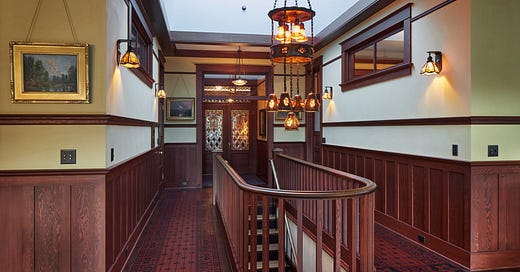Many years ago, I returned to work after a week-long men's wilderness immersion in Zion National Park. The small team of elder carpenters I worked with were eager to have me back: stacks of material needed organizing, tools needed maintenance, and god damn if no one had vacuumed the space since I left.
These men, whom I dearly respected, had limited interest in my trip to Zion. Perhaps they assumed that when any group of young-ish men gathered in a wild place, the activity menu was clear: hiking, beer, guns. Maybe paragliding. Things that involved risk, challenge, and that messy space between vulnerability and reward.
Reality wasn’t so different beneath the surface. We hiked in the sandstone hoodoos, drank tea instead of beer, practiced martial arts and coming back to center. Over and over again. Especially when it got uncomfortable: when someone thought they would fall, or be shamed for speaking up. Back to center, the breath, connection.
Back at home, I was working on an historical restoration project in a firehouse built in the early 1900s, when brigades still used horse-drawn buggies. The clients had installed a fancy elevator where once the horse stalls were full of hay and manure. Imagine the elevator lovechild of Dr. Who and a Fairmont Hotel.
Mauricio the cabinetmaker was working on the massive clear cedar walls of said elevator when I returned. He asked for my help, and without thinking, I set down my chisel on the window ledge that looked through to the elevator shaft. The window itself was not yet installed.
On my return to the chisel, instead of grasping it, I knocked it through the window frame. To my horror, the business end clipped the cedar wall panel on its way to the basement.
>|<
The chisel tip was fucked. As I made my way back upstairs from retrieving it, I thought I was, too. My job was over, I told myself. Whatever I'd learned in Zion about being present in my life obviously had failed to land.
Mauricio and I removed the 6'x8' panel from the elevator and laid it on sawhorses. It must have weighed two hundred pounds.
Mauricio was quiet as he touched the damaged wood. It was a thumb-sized gash in an otherwise flawless work of art. Without a word, he set to work. With a combination square and a sharp pencil, he scribed a rectangle to encompass the damage.
Filled with shame and fear, I barely registered what he was doing. I might have thought he was assessing the damage so he could accurately report it to the big man. There was one moment in which I began to slink away.
"Stay, Sean," he said, without looking up.
With Elven patience and precision, Mauricio used his chisel and mallet to cut out the marked section. He glued in a suitable piece that protruded slightly, then shaved it flush with a low-angle block plane. By the time he was complete, an hour after my dreadful mistake, the masterful repair was barely noticeable.
We installed the panel and went on with the day.
I sheepishly thanked him for fixing it.
"Yeah," he said.
>|<
What Mauricio demonstrated to me that day was craftsmanship steeped in heart and presence. While I spiraled into shame and story, he simply met what was there. No drama. No punishment. No lecture about being more careful.
Just the quiet mastery of working with what is.
This is what I think about when men tell me they're afraid to do their inner work because they might discover something irreparable about themselves. Or when they avoid looking at their patterns because the damage feels too overwhelming.
Mauricio showed me something profound: There's almost nothing that can't be repaired with the right tools, patience, and willingness to stay present with the damage rather than running from it.
The scar was still there if you knew where to look. But it was integrated, strengthened, part of the beauty of the whole.
Sometimes the places where we've been broken become the strongest parts of our structure.
>|<
Where in your life have you been avoiding the damage, assuming it's irreparable?
What does repair look like for you?





